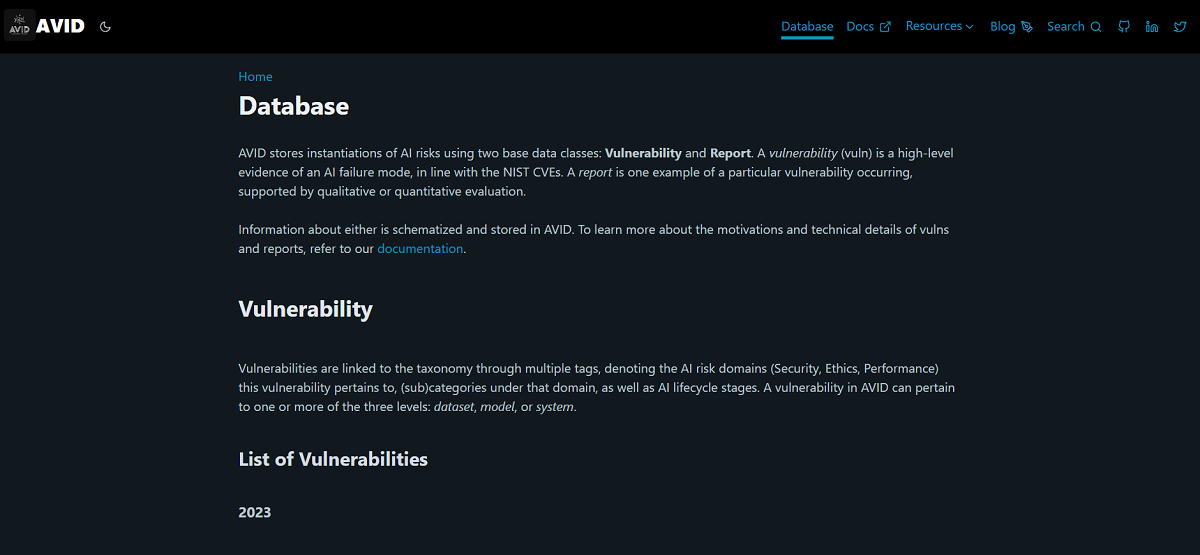The Mindgard solution identified two vulnerabilities in the Zed IDE and our team worked with the developers on a coordinated remediation process.
Fergal Glynn

Artificial intelligence helps organizations save time and improve the quality of their outputs. However, AI isn’t impenetrable; malicious attackers will exploit known weaknesses to exfiltrate data, steal your model, or generate biased outputs that harm the user experience. Compliance, security, and intellectual property are on the line, and it’s never been more important for companies to protect their investment in AI.
It can be challenging to stay on top of the latest threats against AI. Fortunately, the AI Vulnerability Database (AVID), along with other AI vulnerability and AI risk resources, make it much easier to understand and mitigate known threats before attackers use this knowledge against you. Learn about the top AI vulnerabilities facing AI models today.

AVID is an open-source repository that catalogs failures and vulnerabilities for AI models. AVID categorizes known threats based on security, ethics, and performance to help businesses understand and prioritize potential attacks.
We mapped AVID’s findings to four broad risk categories you can use in your own AI vulnerability assessments:
These flaws live within the AI model itself, often in how it processes inputs, generates outputs, or exposes sensitive functionality:

When AI is trained or fed on compromised, biased, or malicious data, its outputs and security suffer:
These weaknesses exist in the environment surrounding your AI, including APIs, dependencies, and hardware:
Not all vulnerabilities are purely technical. Poor oversight, governance, or ethical judgment can be just as dangerous:
AVID catalogs specific AI vulnerabilities, but it’s not the only resource available. There are several other repositories and frameworks that help security teams understand AI risks from different perspectives.
Focused on ethics, governance, and systemic risks, the MIT AI Risk Repository organizes AI-related hazards beyond technical exploits. It doesn’t track vulnerabilities like a CVE database, but it’s valuable for connecting technical flaws to business, compliance, and societal impacts.

MITRE ATLAS™ is modeled after MITRE ATT&CK® and maps how adversaries exploit AI systems through tactics like data poisoning, model evasion, and prompt injection. Mindgard’s ATLAS™ Adviser takes this framework a step further by linking red teaming results directly to ATLAS™, standardizing how organizations measure AI security.
The NIST AI Risk Management Framework (RMF) is a U.S. framework that guides organizations on how to identify, measure, and manage risks in AI systems. It emphasizes trustworthy AI principles (fairness, transparency, and resilience), making it a useful complement to vulnerability-focused databases.
The OECD AI Policy Observatory provides research and policy resources on global AI risks, including governance frameworks and ethical guidelines. While it’s not a vulnerability tracker, it’s helpful for organizations operating across borders who need to align with international standards.
The European Union Agency for Cybersecurity (ENISA) publishes guidance on securing AI systems against adversarial attacks and supply chain threats. These reports provide regional best practices and sector-specific insights.
Best known for its Top 10 lists in web application security, OWASP has expanded into AI and machine learning risks. The OWASP Top 10 for LLM Applications outlines common threats such as prompt injection, data leakage, and insecure plugin design.
While not a vulnerability database, OWASP provides developer-focused guidance that helps teams translate abstract risks into secure coding practices, making it a practical complement to AVID, ATLAS™, and other frameworks.
Together, these resources create a layered view for a more comprehensive understanding of AI-specific risks. AVID covers the known vulnerabilities in AI models and systems, the MIT AI Risk Repository covers systemic and ethical risks to watch, MITRE ATLAS™ explains adversary tactics that are already in practice, and NIST, OECD, and ENISA give organizations governance and compliance frameworks to manage AI risks responsibly.
AI is the foundation of modern innovation, but as the AVID database shows, no system is immune to failure or exploitation. From biased algorithms to poisoned datasets and compromised supply chains, vulnerabilities can strike at any stage of your AI lifecycle.
That’s where Mindgard’s Artifact Scanning and Offensive Security solutions come in. Our platform continuously scans for AI-specific vulnerabilities, detects risks before they can be exploited, and provides you with actionable intelligence to keep your models safe. Whether it’s adversarial attacks, data poisoning, or supply chain threats, Mindgard helps you stay one step ahead.
Protect your investment in AI. Book a Mindgard demo today and see how we can safeguard your models from vulnerabilities.
An AI vulnerability database is a centralized repository of known weaknesses and exploits specific to AI applications and systems. AI teams can use databases like AVID to stay informed about threats to models, datasets, and infrastructure.
Yes. Flawed AI decisions have contributed to autonomous vehicle crashes, surgical robot errors, and warehouse accidents, resulting in injuries, costly recalls, and even fatalities.
AI security isn’t a “set it and forget it” process. You should regularly monitor AI vulnerability databases. Ideally, you should integrate real-time alerts into your DevSecOps pipeline, so you can patch or retrain models before attackers exploit them.